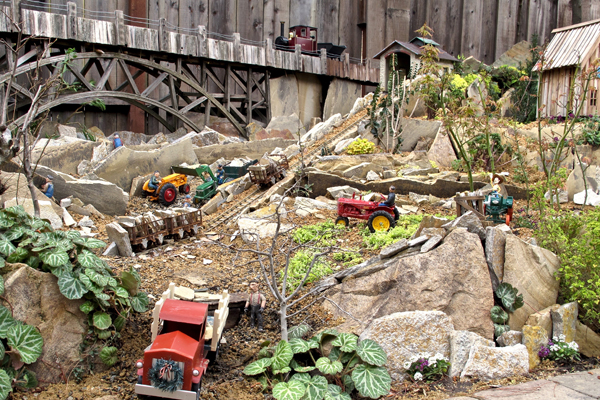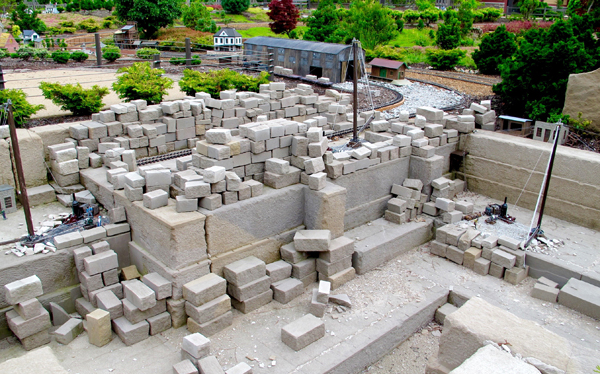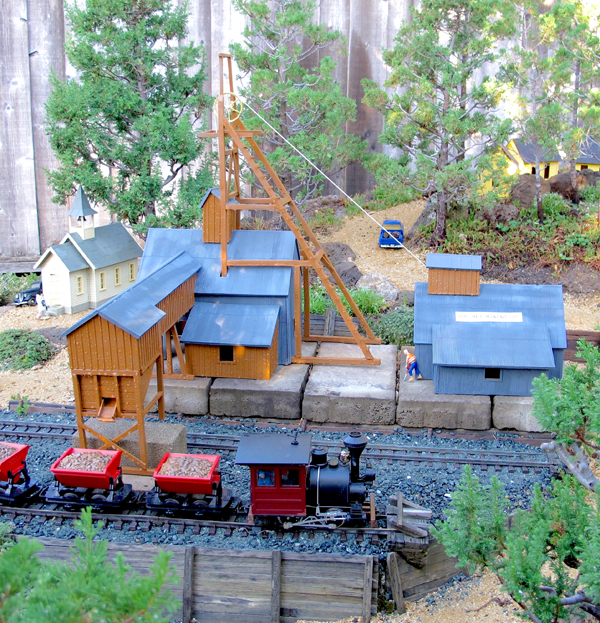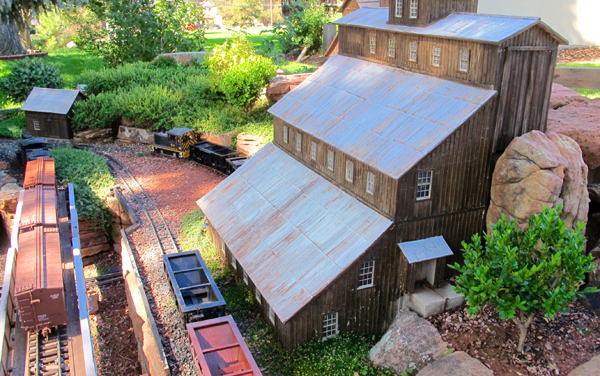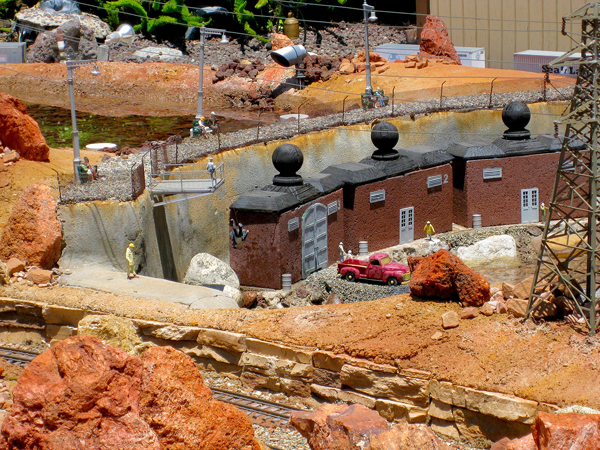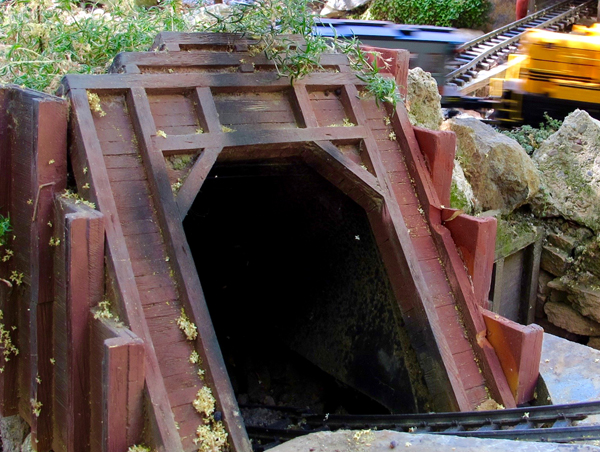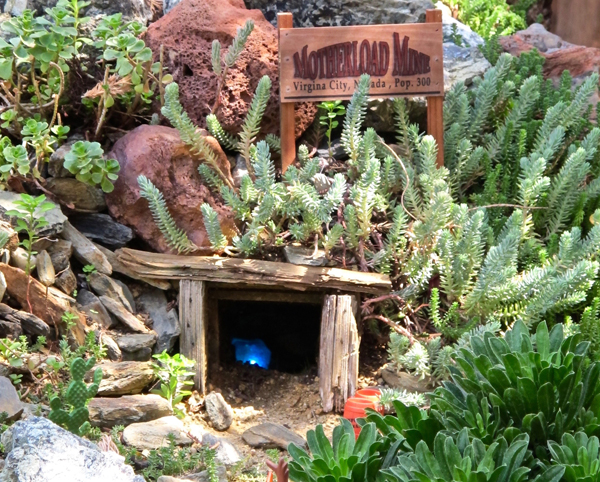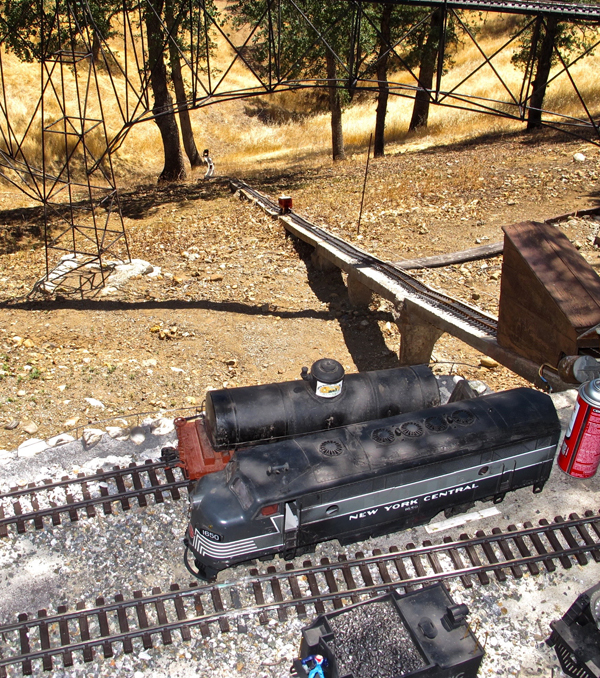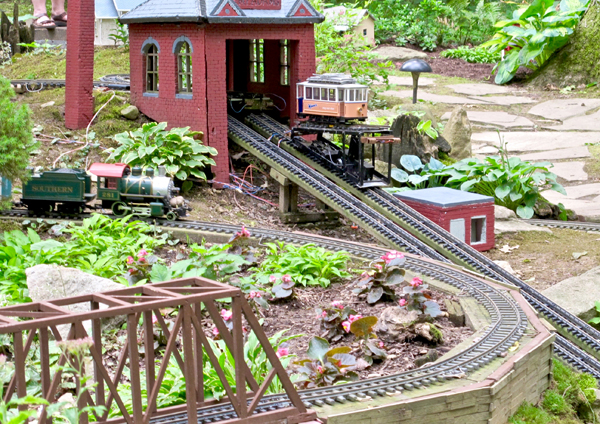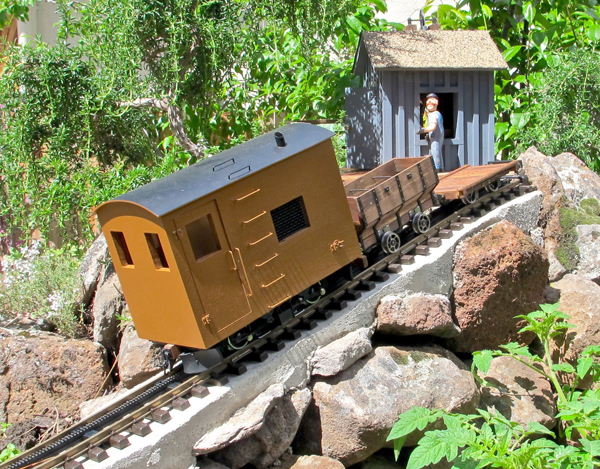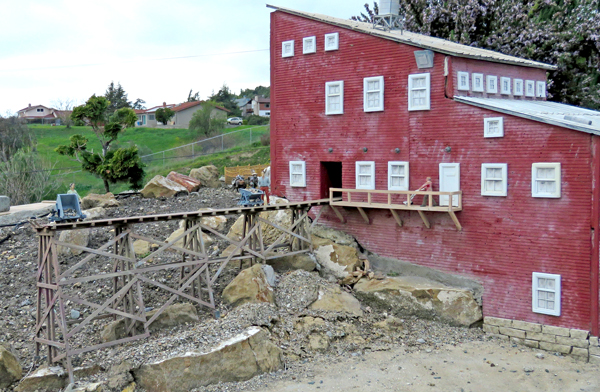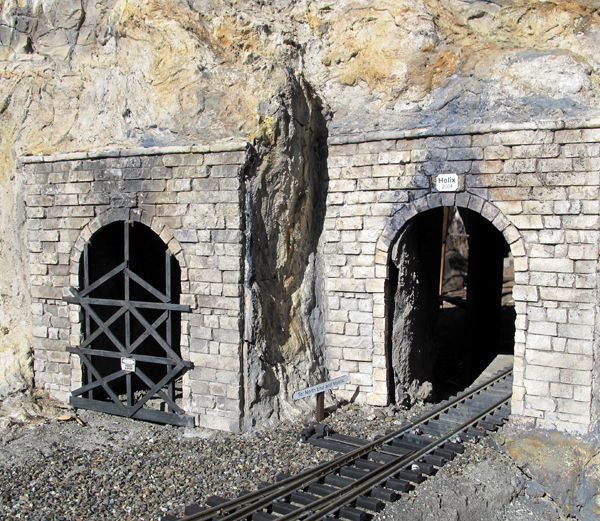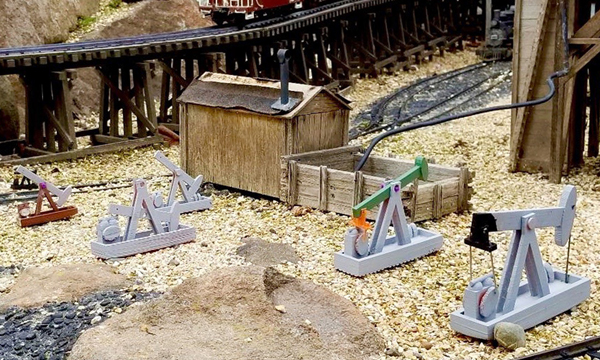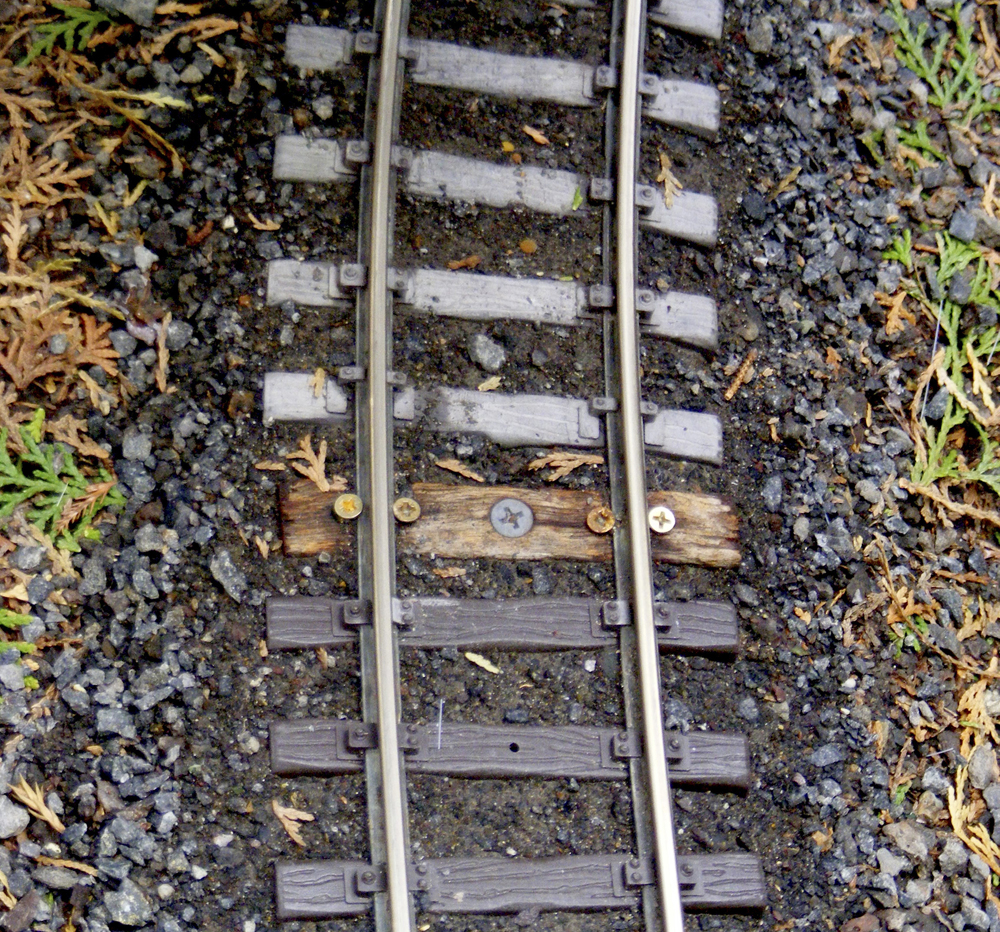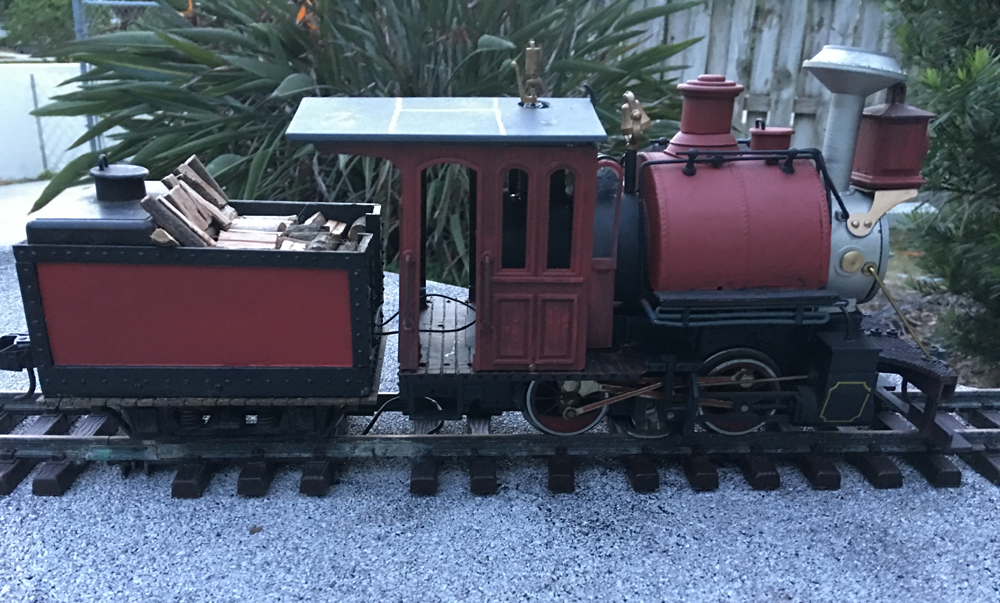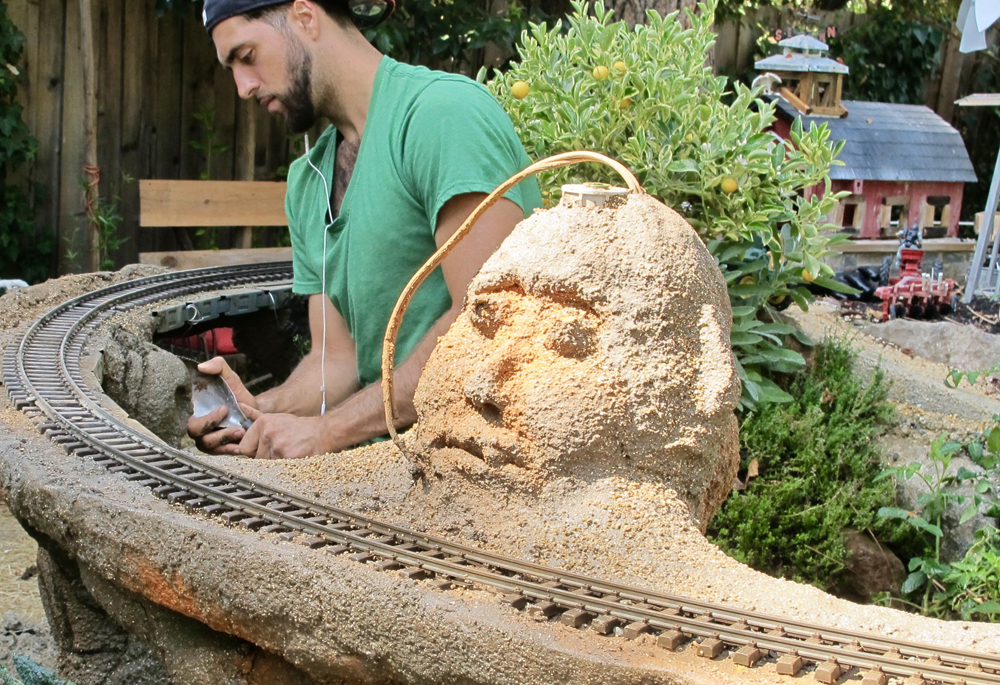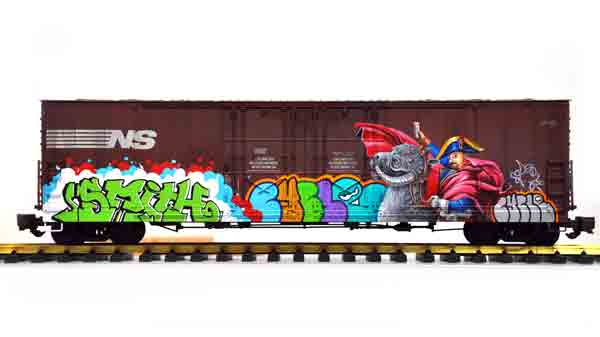To hollow out a mine or build a rock quarry is to fall in love with the versatility and artistry of stonework, a more forgiving modeling medium than plants. Thanks to gravity, we can stack natural stones to create stable structures. If the rocks will be subjected to high winds or animal or human traffic, then mortar, concrete bonding adhesive, or exterior-grade glue will hold it all in place. Here I’ll show how modelers shape hardscape into mine portals and bowl-shaped quarries. Some have stone-supported incline railroads hauling ore; most are fringed in nature’s greenery.
Unearthing ore
The gravel division of my Agriculture & Gravel Elevated (photo 1) recently expanded to include slate processing for three reasons. First, the slate cars (GR product review, Feb. 2014) are winners—rusting replicas of wagons used in Welsh quarries carry nano-chips of genuine slate.
Second, I couldn’t believe my eyes when I found a source for 1″-thick slate, covered in fossils! Mineral deposits have “grown” into fern-like patterns that look like shadows of trees on my distant mountains (see “Plant portraits”). I leaned and overlapped many of these flagstones to quickly terrace 5′ cliffs on a one-sided mountain, where a dog-bone loop returns in my narrow yard. The stepped-bowl shape of the quarry pit hides benchwork posts and makes a handy transition from bushier ground-level landscaping up to the alpine look of miniature scenery.
Last, natural fissures, helped by a hand-guarded cold chisel, a three-pound hammer, and eye protection, create piles of scale slate ready to be loaded onto wagons. I view this scene sitting on my hand-made slate bench, with tea, and dream how I’ll stage it differently next time.
During air travel, I’ve gazed down upon huge open-pit mines. Colorful, terraced chasms span miles near the Rockies. In nearby Arizona, Gary and Peggy Martin carved out a similar deep copper mine that we could walk into (GR, April 2008). Their Eagle Mountain Railroad snakes four feet down inside the rim on terraces spiraling to the bottom.
Taltree Arboretum in Indiana quarries blocks of stone in a pit lined with larger stone (photo 2). Trains access the quarry from several levels, helped by well-rigged cranes near sidings. Junipers ring the rim.
Minescapes
Roger and Jeane Samuelsen model a mine’s processing plant (photo 3), wherein gold-ore cars travel between the stamp mill and the You Bet Mining Co. Adequate irrigation, spring fertilization, and annual pruning of their dwarf trees keep their scenery in great shape. Pavers (placed over 4-6″ of tamped gravel) keep the foundation level and relatively clean of debris for showing off a few workers. Contrasting gold fines (decomposed granite) compact over the road area to a depth of 3-4″, so that miners can find their way home to cheery yellow cabins. Strong wooden retaining walls (GR, Aug. 2012) keep the yard level and retain the slope above, where thyme and sweet alyssum drip over the edge.
Doug and Ricki Mayes artfully weathered a complex of mine buildings for their Colorado & Sparktown Railroad (photo 4). They chose a groundcover of red-rock dust to model their geography and match the boulders, which retain the slope. Dwarf boxwood trees (Buxus sp.) add height while Irish moss (Sagina subulata, Zones 5-10) stays super low between the track and the front windows.
Poetic portals
Three mines show a range of treatment. Faith and Roger Clarkson, with their crew, modeled an extensive mining industry on their Fabing Railroad (photo 5), where mine portals line up for work.
In photo 6, Dennis Winger and Susan Patterson’s Folsom Eastern Railroad Company runs near California’s Mother Lode, where Empire Mine sardined dozens of gold miners into long rail cars that were pulleyed up and down into the sloped underground tube. Docents there told me that much gold remains deep in that mine, if one can efficiently pump out the groundwater.
The greening-your-mine award goes to Marc and Colleen Grzan’s most gardeny portal, surrounded by signage and succulents (photo 7). Small but effective, the mom ’n’ pop mine appears quite active, due to the lit lantern deep in the hole.
Incline/funicular/cog
To climb grades from 8% to 71% (the world’s steepest railroad), trains start with geared locomotives, helper engines, and switchbacks until grades get too steep. Winched cables pull cars up long runs, then use the cables to brake them going down (photo 8), as in Fred Lourence’s Hilltop Southwestern Railroad.
In the style of a funicular railroad, Jack and Kathie Griffin’s Grandymon Lake Railroad runs side-by-side powered track with toothed cog strips (called “rack”) between the rails (photo 9). Prototypes use gravity and counterbalancing; one funicular car goes up while the other goes down, tied to the same cable. Would you like to tour a salt mine and ride the world’s oldest funicular railroad? It’s in Saltzberg (salt mountain). Read about and see photos of the many funicular railroads around the world at https://en.wikipedia.org/wiki/Funicular
To the top
As more of us decide to elevate our railroads to save our knees, mines and quarries could scenic the area between benchwork posts (photo 1) with easy maintenance (blower). Those with ground-level railways might quickly add a small back-and-forth mine line near the top of your mountain (photos 3, 9, and 10).
I commissioned my grandson, Lake Phillips, to build an incline railroad to access a closed-pit mineshaft. The wooden shack’s roof opens to a cabled wheel, just visible in photo 10; a cable runs from the invisible load inside to a counter-balanced, cast-concrete weight mounted behind this shack over a redwood truss-and-pulley system.
Lake scratchbuilt a 7/8″-scale box cab, then mounted it on an LGB rack-loco chassis, adding switches, smoke unit, and fan inside. LGB’s rack strips keep the train from speeding down the 13% grade and also help it climb. An automatic reversing unit calls attention to the industry atop Mt. Rosemary.
Elevation created by stone is great for contrasting deep mines. Upper lines cross a lower rail line and ultimately bring the railroad closer to eye level. To show activity, why not stage the mine to play out a new story for each of your open houses? This gardener thinks the best mines allow for green jewels to grow in the cracks.
Anthropogenic microfeature
Geologists call human-made landforms on the Earth’s surface or in shallow water “anthropogenic” because of the human-transported materials or rock. Soil-conservation terraces and mining pits originate from deposition (levees) or removal (quarries). Lately, geologists have proposed naming a new cycle, called Anthropocene—an era we model when we access these landforms with scale tractors and trains. Visit https://bit.ly/2GD8hr9
• Search GardenRailways.com and use keywords “rock structure” for more than 40 stories, some with how-to instruction.
• Search “Google Images” for “slate quarry,” “mine portal,” “mine rail,” etc. for inspirational photos. Click on image to get location and more.
• Get in the car and tour your local stone quarry, gravel pit, and mine.
Regional gardening reports
How have you landscaped or accessorized your mine?
Ray Turner
San Jose, California, Zone 9
Ore
My Mystic Mountain Mining & Manufacturing is freelance and scratchbuilt, with 120 pounds of cast concrete around the mine and mill. On the side of the mine building is a trestle (painted styrene) on which workers push the tailings and dump them over the side. The ore carts are 0n30 Bachmann models. The large rocks are just what I dug out of the ground here; the smaller ones, representing tailings, are 0-scale ballast. The fine “dust” particles are granite fines used for setting flagstone. Ore is loaded into ore cars below the extension, which is made of acrylic instead of concrete, like the rest of the building.
Richard Friedman
Sacramento, California, Zone 9
Oil
I saw many oil pumps in Tulsa when I was there for last-year’s convention. However, I wasn’t able to find any in large scale so I designed some in Tinkercad and printed them in various sizes. I’ll be trying to make some rolling hills on a large-scale module and dot them with these oil jacks. The rolling hills are complicated by the fact that I’ve only got about 15-20″ from the front to the back of this module. I’m thinking of trying 1/4″ hardware cloth and plaster-gauze to keep it light and relatively flexible.





